

PHY 1150
Second Hour Exam
March 11, 1998 
| Return to PHY 1150's Home Page |
This is a multiple-choice exam. That means there is no partial credit. But it also means there are no multiple-part questions. Take your time. None of the questions are intended to be "trick questions". If you do a calculation and have something like 12.345 for an answer and I have 12.346, it is probably just a round-off error (mine or yours).
All I want is the "scantron" sheet, the "bubble sheet", or the answer sheet. You can keep the questions from the exam. The solutions to the questions will be posted on the world wide web tomorrow. The results of the exam will be posted, by social security number, outside my door (Room 126) shortly after they are back from Academic Testing Services.
For every question, also consider, as a possible answer,
E) none of the above.
Possibly useful information (if you think of other equations that might be useful, come see me and I'll put them on the board for everyone):
|
v = v i + a t v 2 = vi 2 + 2 a ( s - si ) sin cos tan F = m a F12 = - F21 V = Vx i + Vy j + Vz k w = mg g = 10 m/s2 Ff,max = µ n v = r ac = v2 / r Fc = m v 2 / r Fg = G M m / r 2 G = 6.67 x 10-11 N m 2 / kg 2 ME = 5.98 x 1024 kg RE = 4 200 km = 4.2 x 106 m |
P = KE = (1/2) m v2 W = PEg = m g h F = - k x PEel = (1/2) k x 2
s = r
I =
Xcm = [ Y cm = [ KE = (1/2) I
Fthrust = [ W = |
For every question, also consider, as a possible answer,
E) none of the above.
1. How much work is done by gravity on a skier who weighs 600 N as the skier moves 500 m along a hill that makes an angle of 30° with the horizontal?
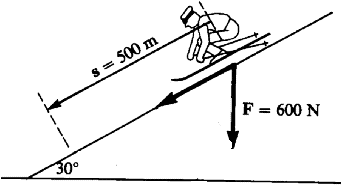
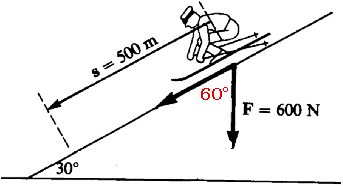
![]()
Be careful with the angle theta. Theta is the angle between F and D so that means it is 60o in this case!
A) 50,000 JB) 100,000 J
C) 150,000 J
D) 200,000 J
2. An electric bill lists 1284 kW-h as the energy used for a month. How many joules of energy is this? [ If the charge is 11.5 cents per kW-h, what is the total bill? ]
E = 1284 kW-h [ 103 W / kW ] [ 3 600 s / h ]E = 4.62 x 109 W-s [ J / W-s ]
E = 4.62 x 10 9 J
This is excerpted from homework problem 6.19 but the answer in the homework solution to 6.19 is incorrect. The incorrect answer in the homework solution was 4.62 x 10 6 J. Either the correct answer of E) or the incorrect answer of C) was counted as correct. I even counted A) as correct!
A) 14 766 JB) 1.48 x 106 J
C) 4.62 x 10 6 J
D) 9.24 x 10 6 J
E) none of the above
3. The output of a common student laboratory laser is about 250 milliwatts (250 mW). How much energy is delivered in one hour?
This is homework problem 6.22 but the solution there has an error. The incorrect answer in the homework solution would be B). Either B) or E) was counted as correct.
A) 0.250 WB) 0.90 W
C) 1.20 W
D) 15.0 W
E) none of the above
4. What is the kinetic energy of a 1,750 kg car traveling at 80 km/h?


A) 1.95 x 104 JB) 1.40 x 105 J
C) 4.32 x 10 5 J
D) 1.12 x 107 J
5. A ski slope is inclined at an angle of 20° and is 600 m long. Find the change in potential energy of a 70-kg skier who goes down this slope.

A) 0.7 x 105 JB) 1.4 x 10 5 J
C) 3.5 x 10 5 J
D) 4.2 x 10 5 J
6. In loading a certain dart gun, the dart is pushed in 12 cm before the gun is cocked. A force of 20 N is required at the end. What is the spring constant of the spring in the gun?
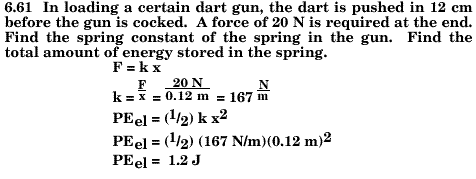
A) 16.7 N/mB) 167 N/m
C) 1 670 N/m
D) 1.67 N/m
7. An arrow with a mass of 0.2 kg is shot straight up into the air so it goes to a height of 40 m. It then comes down and penetrates 25 cm vertically into the ground. What average upward force does the ground exert on the arrow while stopping it?
At the top of the arrows path it has total energy equal to its gravitational potential energy,
All this gravitational potential energy is converted into kinetic energy just before the arrow strikes the ground. Then it is converted into heat energy as the ground does work on the arrow in bringing it to rest,
F = E / d
F = 78.4 J / 0.25 m
F = 313.6 N
Here is a similar problem from the homework:
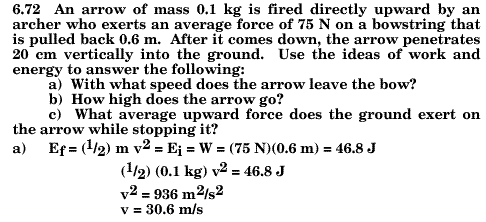

A) 78 NB) 87 N
C) 314 N
D) 413 N
8. At what speed must a 3,600 kg truck travel to have the same momentum as a 1,200 kg that is traveling at 90 km/h?
p truck = m truck v truck = m car v car = p car
(3600 kg) v truck = (1200 kg) (90 km/h)
v truck = (1200 kg) (90 km/h) / 3600 kg
v truck = 30 km / h
Here is a similar homework problem:
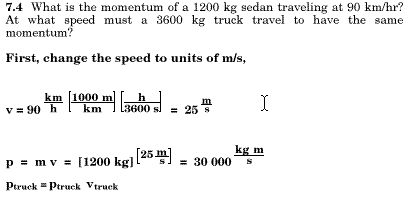

A) 30 km/hB) 60 km/h
C) 90 km/h
D) 120 km/h
9. A 150 g baseball initially traveling at 30 m/s is struck by a bat and leaves in the opposite direction at 35 m/s. What is the impulse delivered by the bat?
Impulse = change in momentumImpulse =
p = pf - pi
p = (0.150 kg) (- 35 m/s) - (0.150 kg) (30 m/s)
p = (0.150 kg) (- 65 m/s)
p = - 9.75 kg m / s

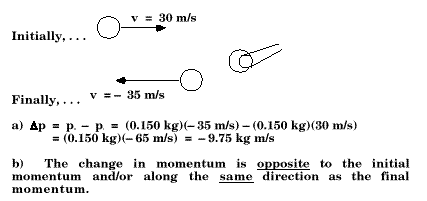

A) 3.45 kg m/sB) 5.97 kg m/s
C) 7.95 kg m/s
D) 9.75 kg m/s
10. A 600 kg cannon fires a 5 kg cannonball with a horizontal muzzle velocity of 120 m/s. What is the recoil velocity of the cannon?
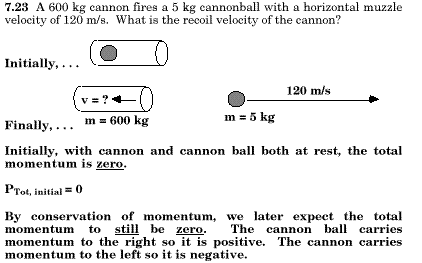

A) 12 m/sB) 6 m/s
C) 2 m/s
D) 1 m/s
11. A 600 g glider sits at rest on an air track when it is struck by a 250 g glider traveling 25 cm/s. The two couple and stick together. What is their common, final velocity?
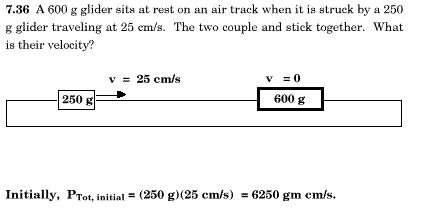
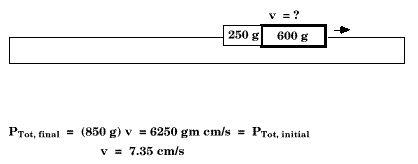
A) 3.35 cm/sB) 5.35 cm/s
C) 7.35 cm/s
D) 9.80 cm/s
12. A 200-g glider on an air track moves to the right at 50 cm/s. A 300-g glider on an air track moves to the left at 90 cm/s. The two gliders collide inelastically -- that is, they collide and stick together. What is their common, final velocity vf?
Pf = (Mtot) vf = m1 v1 + m2 v2 = Pi
Mtot = m1 + m2 = 200 g + 300 g
Mtot = 500 g
( 500 g ) vf = (200 g) ( 50 cm/s ) + (300 g) ( - 90 cm/s)
( 500 g ) vf = 10 000 g cm/s - 27 000 g cm/s
( 500 g ) vf = - 17 000 g cm/s
vf = ( - 17 000 g cm/s ) / 500 g
vf = - 34 cm/s
this is to the left
A) 14 cm/s to the leftB) 17 cm/s to the right
C) 28 cm/s to the right
D) 34 cm/s to the left
13. Exhaust gasses leave a certain rocket with a mass flow rate of 1 250 kg/s. What must be the exhaust speed of these gasses in order to lift a 50 000 kg rocket from its launch pad? (use g = 10 m/s2) ?
Fthrust = M g
Fthrust = M g = (50 000 kg) (10 m/s2)
Fthrust = 500 000 N
Fthrust = [ ![]() m
/
m
/ ![]() t ]
u
t ]
u
[ ![]() m
/
m
/ ![]() t ]
u = 500 000 N
t ]
u = 500 000 N
[ 1 250 kg / s ] u = 500 000 N
u = 500 000 N ] / [ 1 250 kg / s]
u = 400 m/s
A) 200 m/sB) 300 m/s
C) 400 m/s
D) 500 m/s
14. A man who weighs 800 N climbs 4.0 m up a 6.0 m ladder that leans against a smooth (i e, frictionless) wall at an angle of 60o with the horizontal as shown here. The ladder is uniform so its center of mass is 3 m from the foot. What must be the minimum coefficient of static friction between the ground and the foot of the ladder if it is not to slip?
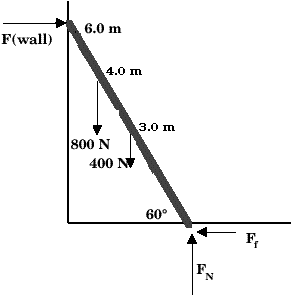
The first condition of equilibrium deals with only the forces:
Fwall = Ff
Fnet,y = FN - 800 N - 400 N = 0
FN = 1200 N
The secondition of equilibrium deals with torques:
Calculate torques about the foot of the ladder:
Ff:= 0
FN:
= 0
400N:
ccw = (3.0 m) (400 N) sin 30o = (3.0 m)(400N)(0.5) = 600 m-N
800N:
ccw = (4.0 m) (800 N) sin 30 o = (4.0 m)(800N)(0.5) = 1600 m-N
Fwall:
cw = (6.0 m) ( Fwall ) sin 60 o = (6.0 m)( Fwall )(0.866) = 5.2 m Fwall
cw =

ccw
5.2 m Fwall = 600 m-N + 1600 m-N
5.2 m Fwall = 2200 m-N
Fwall = 2200 m-N / 5.2 m
Fwall = 423 N
And we already know
Ff = 423 N
Ff = ![]() FN
FN
![]() =
Ff / FN
=
Ff / FN
![]() =
423 N / 1200 N
=
423 N / 1200 N
![]() =
0.35
=
0.35
A) 0.15B) 0.35
C) 0.55
D) 0.75
15. A solid disk, with moment of inertia I = (1/2) M R2, rolls without slipping down a hill from a height of 1.0 m. The disk starts at rest. What is its linear speed at the bottom of the hill?
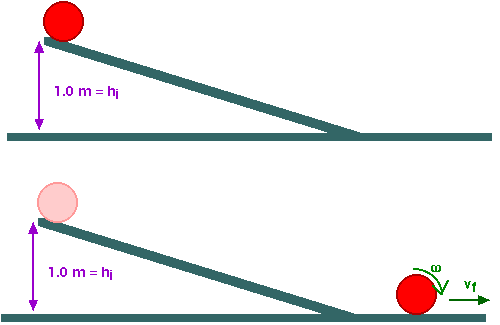
Ef = Ei
KEf = PE i
(1/2) M
v2 + (1/2) I ![]() 2 = M g hi
2 = M g hi
(1/2) M v2 + (1/2) [ (1/2) M R2 ] [ v / R ] 2 = M g hi
(1/2) v2 + (1/2) [ (1/2) R2 ] [ v / R ] 2 = g hi
(3/4) v2 = g hi
v2 =(4/3) g hi
v2 =(4/3) (9.8 m/s2) ( 1.0 m)
v2 = 13.07 m2/s 2
v = 3.62 m/s
A) 1.81 m/sB) 3.62 m/s
C) 7.52 m/s
D) 9.80 m/s
| Return to PHY 1150's Home Page |
(c) Doug Davis, 1998; all rights reserved